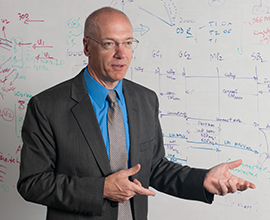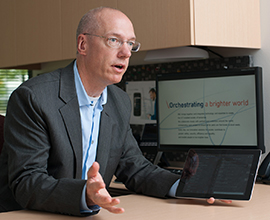Government accreditation of NEC's UNIVERGE 3C platform opens many doors
In 2014, NEC's UNIVERGE 3C software-based unified communications and collaboration solution was accredited by an organization that arguably demands the most stringent and rigorous standards in the world: the United States Department of Defense (DoD). Kurt Jacobs fostered a successful government-industry partnership for unified communications advancement that is providing global public sector organizations with a high-performing, cost-effective and secure communication platform for today and the future. Leading a diverse development and engineering team, he extended the capabilities of NEC's framework for the Smart Enterprise (*) into new markets that have challenging global requirements and expectations.
(*framework for the Smart Enterprise is a modular set of NEC technologies which enables IT organizations to create a strong IT platform by integrating IT and communications.)
Unified communication and collaboration: the new gold standard for software communications?
 --What exactly is UNIVERGE 3C?
--What exactly is UNIVERGE 3C?
Kurt:
UNIVERGE 3C is a new type of unified communications and collaboration product that provides everything from voice, video, text, collaboration, instant messaging and mobility on an all-in-one communications platform running on enterprise IT infrastructure. The platform is user centric because it offers a seamless unified communications experience across any device, including desktop, tablet or mobile, without the need for complex integration. It is IT centric because it can be deployed using standard IT infrastructure as a software service with industry standard protocols and technology. These attributes make it especially valuable to government customers because they can simply extend their existing data infrastructure to enable unified communications with UNIVERGE 3C rather than install separate systems. This architecture is unique in the industry in providing a range of secure, mission critical communication means and methods for diverse and distributed organizations such as government, defense and public sector markets. Additionally, the services are an integral part of NEC's solutions for the Smart Enterprise available to any customer today.
--NEC's unified communications platform earned accreditation from arguably one of the most demanding institutions in the world – the United States Department of Defense. How significant is that?
Kurt:
It is hugely significant because of the sheer volume, scope and depth of the requirements the US Defense Department established for a globally deployed, all-encompassing unified communication platform. The US government has an audacious objective to convert a three-million line legacy voice-only system to a standards-based, end-to-end IP unified communication system for voice, video, messaging and mobility within a decade. Given the nature of its mission, the requirements include everything from security, IPv6, interoperability, performance, scalability, and a capability to support future unified communication, collaboration, devices and technologies require.
Our team engaged and worked with the government stakeholders over many months to both meet the current requirements but also to build out a roadmap for what has become a "unified capabilities" vision of a flexible and scalable platform for the future. The project had a much longer-term view than what we typically see in the general enterprise market. Fortunately, NEC is one of the few companies in the world that allows a team like ours to invest in the long game, not just with a customer but an entire market segment. NEC has become a trusted industry partner helping to fulfill the DoD's vision of unified capabilities at and above their high standards. NEC knows that if we meet the military's standards and goals, we also meet the majority of requirements for other public sector and government organizations across the globe.
US DoD certified communication solutions to benefit organizations worldwide

--Why was NEC's unified communications platform specifically selected for US DoD accreditation?
Kurt:
In order to be selected, a military customer has to recognize your unique value and capabilities and then nominate you as a sponsor. NEC's distributed architecture, commitment to standards-based technology and willingness to work with not only the US DoD but also other accredited technology partners were key reasons for our selection. NEC was the first to be accredited with an end-to-end standard SIP solution that also meets all the IPv6, security and assured services requirements. Other solutions were and are dependent on propriety products and protocols. NEC's UNIVERGE 3C session controller supports commercial off-the-shelf third-party gateways, end instruments, devices and applications. This future proofs the organization's communication platform while lowering costs and providing choice. By using open standards, we connect different solutions, vendors and value to create an ecosystem of products and solutions that is more flexible and powerful.
NEC took a race car approach to this program, focusing much time and energy on both development and working with the test labs. We cooperatively fine tune tuned the under-the-hood mechanics powering the latest unified communication features and functions. Security, device management, fault tolerance, interoperability and performance are not the things an everyday user or administrator sees, but they would feel the an impact if they weren't done right. NEC maintains a consistent presence in the US DoD test facilities to make sure the system stays current and adaptive to the changing "cyber track" conditions. It's our teams' tireless efforts in the labs and with the customer that pay big dividends because government organizations need platforms that offer secure, cost-effective, interoperable platforms with a very long tenure.
--What are the key advantages for public sector, government and defense customers?
Kurt:
From police and fire departments to military operations and defense, all public sector customers are mission critical and demand high availability. Our unique active-active redundancy architecture for communication session control provides system continuity in the case of network outages or disaster. Whether deployed as premise, cloud or hybrid, the system adapts to maintain robust communication availability for users. Since the platform is software-based, it has the native ability to be virtually infinitely scalable and divisible. Public-sector installations are distributed and located over the span of cities, counties, states, or nations. For military and defense clients, installations can span the globe from satellite communications to mobile units on vehicles, ships and aircraft.
Furthermore, public sector organizations are complex institutions encompassing both fixed and mobile call centers, operation centers and knowledge workers. The unified communications and collaboration solutions have to be flexible and capable of supporting a broad range of existing and future applications. The UNIVERGE 3C communication services, NEC's framework for the Smart Enterprise and our ecosystem of accredited solution partners are easily deployed in whole or part to meet those diverse internal requirements and needs. In many cases, the capability is already available in the software application suite or is incrementally licensed. Such cost-effective, use-as-you-need services are ideal for clients who have to demonstrate appropriate spending and responsible stewardship to tax payers and constituents.
Forging a successful government-industry partnership
--How difficult was it to steer a successful government-industry partnership with the DoD?
Kurt:
You certainly have to roll up your sleeves and do the hard work. Building the technology and aligning on a common vision took a couple of years of engagement because the technology and industry is always a moving target. As with any lasting partnership, both sides have to invest time and energy to forge a relationship based on mutual understanding and objectives. The strong partnership allowed us to reconcile the intersection of future vision, technology realities and resource constraints to plot an optimal path forward. It made sense on both sides to make the commitment to a cooperative research and development arrangement because we were in uncharted territory. The partnership was important because all sides knew we were in it for the long haul, and it enabled us to focus our energy on the objective, not the relationship.
NEC's ability to offer a standard-protocol, software-based, IT infrastructure-compatible unified communication platform greatly facilitated the partnership because this was exactly what the US DoD was looking for to fulfill their vision for end-to-end unified capabilities. NEC's demonstrated capability to natively support mobility then led us to the cooperative research arrangement accelerating the requirements definition for those capabilities. NEC benefited from the cooperative development arrangement which earned us a spot on the global information grid test network, deployment on the joint interoperability test system, and upfront access to each other's architects and engineers. Both sides continue to learn a great deal about the challenges facing us, from the reality of today's end user to the vision of a future end result.
--How tough was the DoD's rigorous testing process?
Kurt:
NEC is known for our quality and ability to develop and deploy complex communications systems, so we had the fundamental talent and capacity available going into the testing process. What is different with this accreditation and certification process is that they test every dimension of the product in one of the most advanced and complex configurations. Each dimension is tested for interoperability and performance on a global test network and includes every other US DoD-approved system and application. Over three thousand pages of requirements, thousands of test cases and scenarios, tens of thousands of items in checklists, audits and assessments, not to mention numerous undisclosed automated tools for security scans and attacks, were used to validate the system operations, IPv6 and cyber security. It takes months to go through the testing with full-time on-site support and a responsive development team working through any issues. Often we are working with our ecosystem partners, and even competitors, when an interoperability issue is found to make sure we resolve any problems before the next customer release. While rigorous, the testing we have done through this process has furthered NEC's shared vision with the US DoD for an end-to-end and standards-based IP unified communication system. Knowing that the systems we are developing offer broad interoperability and high reliability, and meet the highest levels of security and cyber defense is important for all of our customers and markets.
Harnessing military and civilian work experience
 --Has your own experience both in the US armed services and private-sector telecoms software creation helped you see where unified communications can benefit government and public sector organizations
--Has your own experience both in the US armed services and private-sector telecoms software creation helped you see where unified communications can benefit government and public sector organizations
Kurt:
I have been fortunate through both my military experience, first as a full-time active duty and now part-time reserve officer, and my civilian career to work with many countries and government agencies on a wide variety of military, security and humanitarian missions. This has given me a unique perspective on how mission critical communications function, from the tactical boots on ground to crisis-response operation centers and strategic decision makers. Common to success at any of those levels is a communication system that is easy to deploy and use, and is reliable anywhere, anytime and on any device. Interagency and intergovernmental communications is also becoming increasingly important, demanding an increasing level of interoperability and compatibility. At the same time, these organizations across the globe are under pressure to deliver communications at a lower cost and invest in systems that will last longer. It was easy for me to see the synergy between what NEC's unified communications for the Smart Enterprise and collaboration systems could offer and what those organizations needed.
Government and defense organizations are the most cyber-targeted organizations on the planet, with significant year-to-year growth in attacks. The kind of accreditation and testing that UNIVERGE 3C achieved is an imperative prerequisite for that market segment. My military experience did help facilitate understanding and identify customer demand signals because I had an acute appreciation of the challenges they faced when trying to deploy unified communication systems. I already speak their "lingo", and that is usually half the battle in understanding the problems that need solving. I was also able to act as a bridge in discussions with the US DoD visionaries and NECs principal engineers to ensure a fruitful meeting of minds. You can have great technology, but if stakeholders can't communicate properly on a problem, the technology will never truly solve it.
--What was your role in the accrediation project and development of the program?
Kurt:
My role had three hats which I called PM^3 (PM cubed): program management, project management and product management. As program manager, it was my job to coordinate with government stakeholders, architects, engineering teams, requirements writers and, most importantly, the end users to determine the ultimate long-term goals of this ever-growing, constantly-changing, multi-year project. As project manager, I provided the grease to keep it moving, from the operational planning and scheduling to the procurement of resources and aligning the engineering teams from NEC's global development organizations. Finally, as the product manager, I established which features and capabilities to prioritize, what technologies to use, and where to make compromises or suggest requirement updates as the industry evolved. Overall, the program was professionally rewarding because, in addition to myself, the entire team was involved from the big-picture view of what we were trying to achieve all the way down to individual features and capabilities. It is easy to decide what to do today when you are working on a common vision for tomorrow.
Promoting a global public sector ecosystem for software-based communication solutions
 --How you would assess NEC's approach to fostering innovation and collaborative products?
--How you would assess NEC's approach to fostering innovation and collaborative products?
Kurt:
NEC's presence as a true global research and development company for enterprise communication and IT systems was vital in helping us achieve such a high standard of accreditation. As the program developed, our team was able to access a deep pool of engineering and research talent from across the globe to help us work through some of the toughest challenges and issues. The US DoD vision and requirements were so broad and comprehensive that no single development team could do it all. Fortunately, NEC has such a cooperative and sharing environment for technology exchange, we always felt we could find a solution within our own walls.
We also used NEC's diverse global customer base to validate and test ideas, and we got feedback from existing customers and sales channels about potential benefits of the accreditation for the general market. That feedback was invaluable for making decisions on how to best fulfill the US DoD's vision as they wanted a platform that aligned with commercial offerings, standards and implementations. The engagements helped us realize that the attributes and capabilities for security, IPv6, interoperability and performance being certified with the US DoD could also be applied to all customers and markets. I don't think any other communications company outside of NEC has that level of global reach for both development and customer input.
--Could this project help promote an ecosystem of solutions for government and defense organizations worldwide?
Kurt:
Absolutely. The US DoD mission was to transform three million lines from a legacy voice only system to an end-to-end IP system with standards-based unified communications and collaboration running on a common IT infrastructure within a decade. While audacious, NEC's UNIVERGE 3C could offer tangible technologies to help accelerate the US DoD's thinking and vision. A fundamental cornerstone to their vision was to the need to support third-party interoperability for commercial off-the-shelf systems, devices and applications. Previous solutions tended to be closed and proprietary, leading to a risk of inflexibility, early obsolesce and high cost. In our first test cycle, NEC was able to certify the first standard protocol voice, video and messaging devices and systems that meet all IPv6 and security requirements. While not every customer has such a broad and comprehensive vision as the military, almost all are all moving in the same direction in terms of communication modernization.
At a minimum, this demonstrates to customers worldwide that NEC has an open and flexible communications platform built to the highest standards of performance, security and interoperability. Since our accreditation, defense and government customers have been particularly interested in the high level of security support, IPv6 and cross system interoperability between both military and intergovernmental agencies. Being software based, UNIVERGE 3C is ideally suited to contingency and crisis response situations, since it can be easily deployed for small units and operations centers when and where needed.

Personal vision and passions
--How do you see state-of-the-art communication frameworks developing?
Kurt:
The next wave for unified communications and collaboration is already underway in the area of mobility. Our NEC solution uniquely embeds mobility services and applications into the UC platform while still meeting the US DoD's same high standards of performance and security. The foundation of voice, video, messaging, SIP, IPv6, security and interoperability has largely been worked out, and now we are at the stage of expanding the types of devices and users that can access those services. We are at the very early stages in discussions with public sector customers about how software defined networking (SDN) can modernize and dynamically control underlying network infrastructure to achieve similar goals to unified communications in terms of security, performance, cost reduction and interoperability. Beyond that will be how we start bringing devices and sensors into those same robust and secure government enclaves with the Internet of Things (IoT). Be it smart cities, monitoring aircraft engines or tracking vehicles, those things will need to integrate with communication systems and platforms to bring humans into the loop. There is no limit to where this can go in terms of capabilities.
--Looking back, what about the project impressed you most?
Kurt:
The NEC engineering and support teams were the true trailblazers for this initiative. I am extremely proud of them for their dedication, work ethic and passion. In particular how they helped break down this massive undertaking into manageable pieces while never losing sight of the overall objective. They never backed away from a feature or capability, they always found a way. We invested time and energy to fully understand the vision and requirements up front and established a good feedback loop. With that and a bunch of bright people, you can work out how to bring a vision to life and apply the necessary skills and talent. That's is what innovation is about.

--What are you most passionate about in your personal and professional life?
Kurt:
I am up for anything I haven't done before, and I'll try anything once. Outside the office, I'm a cardio workout fiend, be it running, biking or swimming. Probably not a surprise from a Navy guy, I am also a qualified off-shore sailing captain. I do all manner of water and snow sports and have a particular passion for windsurfing and cross country skiing. Whether getting the trim of the sails just right or the wax perfect for the snow conditions, I enjoy understanding the physics of how to get the most from Mother Nature to maximize the human experience.
On the technology side, I love using unified communications and the fact that I use NEC technology to participate in a web collaboration session while working out in the gym or riding my bike to work. While in transition, I can then do a simple, seamless swipe transfer to my desktop and phone. My personal goal is to take communication and collaboration to the next level by integrating it into business processes, organizational operations and everyday human interaction. Perhaps a bit like Star Trek, but I want to see a world where communications are ubiquitous, hassle-free, and integrated into whatever you are trying to do in your personal and professional life. I'm still working on how we are going to get there but, for me, it's the logical destination.
